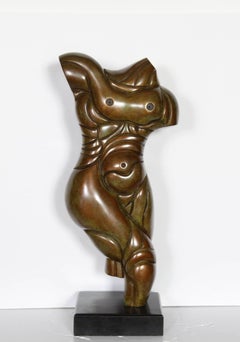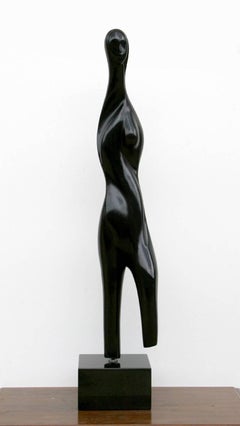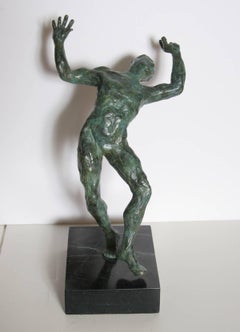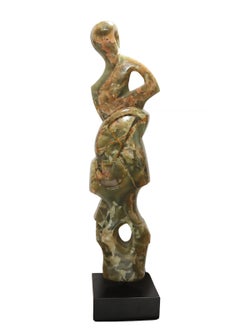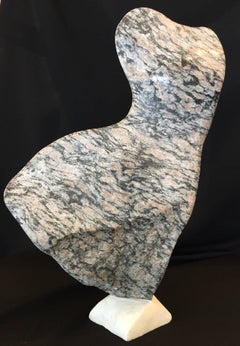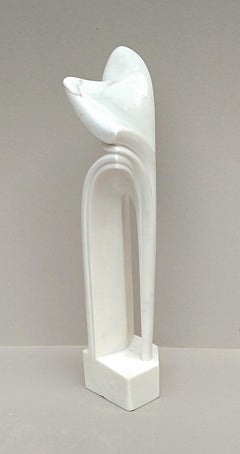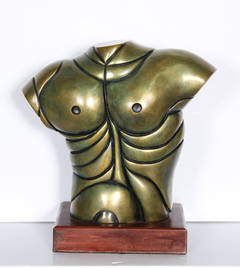Anthony Quinn Figurative Sculptures
to
2
2
1
1
1
Overall Width
to
Overall Height
to
7
6
1
5
2
5
4
4
3
1
1
1
1
5
5
3
3
10
122
102
101
77
7
Artist: Anthony Quinn
Song of Zorba, Bronze Sculpture by Anthony Quinn
By Anthony Quinn
Located in Long Island City, NY
Artist: Anthony Quinn
Title: Song of Zorba
Year: 1984
Medium: Bronze sculpture on marble base, signature and year inscribed
Size: 24 in. x 20 in. x 9 in. (60.96 cm x 50.8 cm x 22.86...
Category
1980s Modern Anthony Quinn Figurative Sculptures
Materials
Marble, Bronze
Prometheus, Modern Bronze Sculpture by Anthony Quinn
By Anthony Quinn
Located in Long Island City, NY
Artist: Anthony Quinn, American (1915 - 2001)
Title: Prometheus
Year: 1988
Medium: Bronze Sculpture, Signature and number inscribed
Edition: 5/8
Size: 22.5 in. x 10.5 in. x 5 in. (57...
Category
1980s Modern Anthony Quinn Figurative Sculptures
Materials
Bronze
Spirit of Zorba, Bronze Sculpture by Anthony Quinn
By Anthony Quinn
Located in Long Island City, NY
Artist: Anthony Quinn, American (1915 - 2001)
Title: Spirit of Zorba
Year: 1984
Medium: Bronze Sculpture, signature, date and edition inscribed
Edition: 49, AP
Size: 16.5 x 9.5 x 8....
Category
1980s Contemporary Anthony Quinn Figurative Sculptures
Materials
Bronze
Nefertiti
By Anthony Quinn
Located in Long Island City, NY
Artist: Anthony Quinn
Title: Nefertiti
Medium: Unique hand-carved black Marble sculpture on marble base, signature inscribed
Size: 34.5 x 8 x 7.5 inches (39 in. with base)
Category
1980s American Modern Anthony Quinn Figurative Sculptures
Materials
Marble, Stone
Spirit of Zorba, Bronze Sculpture by Anthony Quinn
By Anthony Quinn
Located in Long Island City, NY
Artist: Anthony Quinn, American (1915 - 2001)
Title: Spirit of Zorba
Year: 1984
Medium: Bronze Sculpture, signature, date and edition inscribed
Edition: 49, AP
Size: 16.5 x 9.5 x 8....
Category
1980s Contemporary Anthony Quinn Figurative Sculptures
Materials
Bronze
Venus, Unique Carved Green Onyx Sculpture by Anthony Quinn
By Anthony Quinn
Located in Long Island City, NY
Date: circa 1980
Green Onyx sculpture on marble base, signature inscribed at base
Size: 45 x 10 x 10 in. (114.3 x 25.4 x 25.4 cm)
Category
1980s Modern Anthony Quinn Figurative Sculptures
Materials
Marble
Zeus, Modern Bronze Sculpture by Anthony Quinn
By Anthony Quinn
Located in Long Island City, NY
Artist: Anthony Quinn, American (1915 - 2001)
Title: Zeus
Year: 1992
Medium: Bronze Sculpture with Patina, signature, date and number inscribed
Edition: 8/8
Size: 22 in. x 9 in. x 5 ...
Category
1990s Modern Anthony Quinn Figurative Sculptures
Materials
Bronze
Related Items
"Female"
By Michael Patterson
Located in Southampton, NY
Wonderful original granite sculpture by well known contemporary artist Michael Patterson. This work of the female form was completed in 2013. The sculpture is attached to a white m...
Category
21st Century and Contemporary American Modern Anthony Quinn Figurative Sculptures
Materials
Stone
Arch, Sensual White Carrara Statuary Marble Stone Vertical Figurative Sculpture
By Lutfi Romhein
Located in Clermont-Ferrand, Auvergne-Rhône-Alpes
This Carrare statuary marble stone sculpture in a very pure white with slightly colored veins is by Lutfi Romhein.
A graduate from the Academy of Fine A...
Category
2010s Modern Anthony Quinn Figurative Sculptures
Materials
Marble
H 27.56 in W 5.52 in D 4.73 in
Monumental Pair of White Marble Sculptures of Classical Figures
Located in Rome, IT
Standing figure of Julius Caesar wearing a Tunic and holding a billowing drapery with a composition marble square-section pedestal.
. The other figure is of Hannibal.
Provenance fro...
Category
Late 20th Century Modern Anthony Quinn Figurative Sculptures
Materials
Marble
H 104.34 in Dm 31.5 in
Satiro - Original Bronze Sculpture by Giulio Aristide Sartorio
By Giulio Aristide Sartorio
Located in Roma, IT
Bronze head sculpture realized by Giulio Aristide Sartorio, an Italian painter, sculptor and film director from Rome.
Having attended the Rome Institute of Fine Arts, Sartorio presented a Symbolist work at the 1883 International Exposition of Rome. He made friendships with Nino Costa and Gabriele D’Annunzio, and associated with the painters and photographers of the Roman countryside.
His period of greatest renown came at the beginning of the century, when he produced decorative friezes for the 5th Esposizione Internazionale d’Arte of Venice (1903), the Mostra Nazionale of Fine Arts (Milan, Parco Sempione...
Category
Early 20th Century Modern Anthony Quinn Figurative Sculptures
Materials
Bronze
H 9.06 in W 5.32 in D 5.91 in
Georgian Contemporary Sculpture by Irakli Tsuladze - Square of Love
By Irakli Tsuladze
Located in Paris, IDF
Bronze, glass & marble
Irakli Tsuladze is a Georgian sculptor born in 1973 who lives and works in Tbilisi, Georgia. His sculptures present a peculiar unity of substance and emotions...
Category
2010s Contemporary Anthony Quinn Figurative Sculptures
Materials
Marble, Bronze
H 21.66 in W 22.05 in D 7.09 in
Windswept Face Of A Man Marble Sculpture
Located in Lake Worth Beach, FL
Windswept Face Of A Man Marble Sculpture
Signed, on wooden base.
Leon Saulter (1908 - 1986) was active/lived in California born in Poland. Moved to US in 1921. Leon Saulter is known for sculptures, paintings also writer.
Born in Poland on March 31, 1908. By the 1930s, Saulter was active on the Federal Art Project while a resident of Los Angeles.
Exhibitions:
Painters & Sculptors of LA, 1936-40;
Artists Union (LA), 1939;
Stendahl Gallery (LA), 1941;
LACMA, 1940, 1943, 1946
Santa Barbara Museum; Bonita Union High School (Spirit of Youth Learning Industry); David Starr Jordan School, Long Beach (Head).
Museums:
University of Wyoming Art...
Category
1970s Modern Anthony Quinn Figurative Sculptures
Materials
Marble
Bronze Abstract Space Age Book Sculpture LA California Modernist Charna Rickey
By Charna Rickey
Located in Surfside, FL
Charna Rickey 1923 - 2000 Mexican-American Jewish Woman artist.
Signed Bronze House of Books, Architecture Bronze sculpture, signed Charna Rickey and on the front "House of the book." It depicts an open Torah. Original patina.
Approx. dimensions: 7 in. H x 9 in. W x 8.5 in. D. Weight: 13.1 lbs.
Modernist Judaica Sculpture
Born Charna Barsky (Charna Ysabel or Isabel Rickey Barsky) in Chihuahua, Mexico, the future artist lived in Hermosillo and immigrated to Los Angeles when she was 11. She was educated at UCLA and Cal State L.A., she married furniture retailer David Rickey and explored art while raising their three daughters. Moving through phases in terra cotta, bronze, marble and aluminum, she found success later in life. Rickey became one of the original art teachers at Everywoman's Village, a pioneering learning center for women established by three housewives in Van Nuys in 1963. She also taught sculpture at the University of Judaism from 1965 to 1981.
As Rickey became more successful, her sculptures were exhibited in such venues as Artspace Gallery in Woodland Hills and the Courtyard of Century Plaza Towers as part of a 1989 Sculpture Walk produced by the Los Angeles Arts Council. Her sculptures have also found their way into the private collections of such celebrities as Sharon Stone.
Another of Rickey's international creations originally stood at Santa Monica College. In 1985, her 12-foot-high musical sculpture shaped like the Hebrew letter "shin" was moved to the Rubin Academy of Music and Dance at Hebrew University in Jerusalem. The free standing architectural Judaic aluminum work has strings that vibrate in the wind to produce sounds. Rickey also created art pieces for the city of Brea. They commissioned some amazing art pieces by Laddie John Dill, Walter Dusenbery, Woods Davy, Rod Kagan, Pol Bury, Niki de Saint Phalle, Magdalena Abakanowicz, Larry Bell, John Okulick...
Category
20th Century American Modern Anthony Quinn Figurative Sculptures
Materials
Marble, Bronze
Bronze Architectural Model Sculpture Tempio Bretton Architecture Maquette
Located in Surfside, FL
TEMPIO BRETTON: from the catalogue MONUMENTA, 19th International Sculpture Biennale, Antwerp, Belgium.
Tempio Bretton was created in homage to the celebrated English landscapist Capability Brown for the occasion of an exhibition at Bretton Hall in the Yorkshire Sculpture Park , a park in the style of the great master of English garden design. The inclusion in the English garden of a temple ruin, or "eye-catcher," (architectural folly) was used to draw the eye and mind to a focus in time and space, present the beholder with an immediate relationship to an historic past made new within his or her own surroundings, and create a depth of space never before seen in garden design.
I took the idea of the temple ruin eye-catcher and reduced it to a scale at the point where architecture and sculpture merged. Tempio Bretton is not capacious enough to walk into, yet it is considerably larger than a man.
One view of it presents a knot of golden columns clustered together, topped by a dome shape. The only clue from this side to the temple's non-conformity to historic principle is a sharp notch cut into the square base.
Viewed from the opposite side, the cluster of columns capped by an angular top opens up as if to welcome someone in, yet the mysterious core is still impenetrable. These contradictions articulate a confrontation between past and present, and an exciting truth. The past is always at the heart of our constructions in the present.
Walter Dusenbery (born September 21, 1939 in Alameda, California) is an American sculptor. He attended the San Francisco Art Institute, earned an MFA from California College of Arts and Crafts, and then studied in Japan and Italy under Isamu Noguchi. He also held teaching positions at Harvard University and University of California, Berkeley Graduate School of Design. From 1971 to 1988, he lived both in Pietrasanta,Italy, and in Little Italy, New York City. Dusenbery's preferred material is stone, particularly travertine or granite. Dusenbery has a particular interest in adding sculpture to public places, such as federal buildings, to humanize the space, but in 1988, he assembled a show of small, entirely hand-carved alabaster sculptures, called "Walter Dusenbery, The Personal Side," at the Fendrick Gallery in Washington, D.C.. In 1977, Dusenbery created Pedogna, on permanent loan from The Metropolitan Museum of Art to Landmarks, the public art program of The University of Texas at Austin.
That same year, 1988, he was awarded a large commission for the Fulton County Building Atrium in Atlanta, Georgia. The commission was for three fountains and related structures over three stories in height, designed for informal and ceremonial public events, Limestone, marble, granite and travertine fountains, pavilions, seating and meeting areas, performance and concert platforms, staircases and planters for hanging gardens. After completion of the "Atlantacropolis," Dusenbery withdrew from the gallery world and focused his energy on site-specific commissions. (like the landscape works of Maya Lin and Beverly Pepper) Seeking a large-scale stone studio for projects closer to home, he discovered there were none. In 1995, he approached sculptor and patron of sculpture J. Seward Johnson Jr. with the idea of creating a state-of-the-art stone-carving studio, so that American sculptors would not have to travel abroad to realize their work. Johnson agreed to fund such a facility, if Dusenbery would direct it. In 1996, Dusenbery designed the facility for the Stone Division at Johnson Atelier Technical Institute of Sculpture, and was its first director. The facility was situated in "a building resembling an airplane hangar," The studio offered the ability to digitally scan three-dimensional forms. The Stone Division was a success and attracted a strong group of sculptors: Magdalena Abakanowicz, Lawrence Argent, Barry X Ball...
Category
20th Century American Modern Anthony Quinn Figurative Sculptures
Materials
Bronze
H 12.5 in W 3.5 in D 3.5 in
Harmony, 20th century bronze & green marble base, nude man and woman with lyre
By Max Kalish
Located in Beachwood, OH
Max Kalish (American, 1891-1945)
Harmony, c. 1930
Bronze with green marble base
Incised signature on right upper side of base
14 x 9 x 5 inches, excluding base
17 x 10 x 8 inches, including base
Born in Poland March 1, 1891, figurative sculptor Max Kalish came to the United States in 1894, his family settling in Ohio. A talented youth, Kalish enrolled at the Cleveland Institute of Art as a fifteen-year-old, receiving a first-place award for modeling the figure during studies with Herman Matzen. Kalish went to New York City following graduation, studying with Isidore Konti...
Category
1930s American Modern Anthony Quinn Figurative Sculptures
Materials
Marble, Bronze
Inspiratio, Atelier
By Richard MacDonald
Located in Laguna Beach, CA
Formed by two exquisitely defined figures, one the archetype of male perfection, and the other reflecting an image of the ideal female form, these two figures mirror each other, and ...
Category
21st Century and Contemporary Contemporary Anthony Quinn Figurative Sculptures
Materials
Bronze
Star Gazer, Unique Cast Bronze Horse
By Danusia Wurm
Located in Brecon, Powys
Using the lost wax technique, all Danuta's bronzes are one-off originals
Free standing. Rests on carbonised oak block
"The ripped raw edges of Elizabeth Frink...
Category
2010s Contemporary Anthony Quinn Figurative Sculptures
Materials
Bronze
Sydney Kumalo Bronze Minimalist African Modernist Sculpture Figural Female Nude
Located in Surfside, FL
Sydney Kumalo. Features a bronze stylized female figural form sculpture fixed to a marble plinth and wood base. Bears signature on base. Measures 9 1/2" x 4 1/4". There is no edition number on the piece.
Sydney Kumalo (1935 - 1988) was born in Sophiatown, Johannesburg, on 13 April 1935. His was one of the families who had to move out of the "white" city to the South Western Townships, or Soweto. Raised in Diepkloof and educated at Madibane High School, he took with him from old Sophiatown the curious and diverse heritage of its heyday. Art classes in the Catholic school, "Sof' town" blues and jazz, the vibrant street culture and growing defiance of its population of various races who were gradually forced out into separate race-group areas. So it was that these various aspects of his early life created for Kumalo a cultural mix of a Zulu family related to the traditional royal house; city schooling, nascent township music and lingo; growing urbanised political defiance and the deep-rooted Zulu pride and respect for the legends and ancient stories of a tribal people. This mix of old and new cultures was reinforced when he began his studies at the Polly Street Art Centre in 1953 where he became a member of Cecil Skotnes group of serious artists who were encouraged to acquire professional skills. Skotnes introduced a basic training programme with modelling as a component, which marked the introduction of sculpting (in brick-clay) at Polly Street.
Kumalo was Skotnes’ assistant at Polly Street from 1957 to 1964, and having recognised his great talent as a sculptor, Skotnes encouraged him to become a professional artist.
After Kumalo’s very successful assistance with a commission to decorate the St Peter Claver church at Seeisoville near Kroonstad, with painting designs, sculpture and relief panels in 1957, Skotnes arranged for Kumalo to continue his art training by working in Edoardo Villa ’s studio from 1958 to 1960. Working with Villa, he received professional guidance and began to familiarize himself with the technical aspects of sculpting and bronze casting. In 1960 he became an instructor at the Polly Street Art Centre.
Kumalo started exhibiting his work with some of the leading commercial Johannesburg galleries in 1958, and had his first solo exhibition with the Egon Guenther Gallery in 1962. He was a leader of the generation who managed to leave behind the forms of African curios, reject the European-held paternalism which encouraged notions of "naive" and "tribal" African art, and yet still hold fast to the core of the old legends and spiritual values of his people. He introduced these subjects into his bronze sculptures and pastel drawings, evolving his own expressive, contemporary African "style".
Together with Skotnes, Villa, Cecily Sash and Giuseppe Cattaneo, Kumalo became part of the Amadlozi group in 1963. This was a group of artists promoted by the African art collector and gallery director Egon Guenther, and characterised by their exploration of an African idiom in their art. Elza Miles writes that Cecil Skotnes’ friendship with Egon Guenther had a seminal influence on the aspirant artists of Polly Street: “Guenther broadened their experience by introducing them to German Expressionism as well as the sculptural traditions of West and Central Africa. He familiarised them with the work of Ernst Barlach, Käthe Kollwitz, Gustav Seitz, Willi Baumeister and Rudolf Sharf.” It is therefore not surprising that some of Kumalo’s sculptures show an affinity with Barlach’s powerful expressionist works. Guenther organised for the Amadlozi group to hold exhibitions around Italy, in Rome, Venice, Milan and Florence, in both 1963 and 1964.
Kumalo’s career took off in the mid 1960s, with his regular participation in exhibitions in Johannesburg, London, New York and Europe. He also represented South Africa at the Venice Biennale in 1966, and in 1967 participated in the São Paulo Biennale.
EJ De Jager (1992) describes Kumalo’s sculpture as retaining much of the “canon and formal aesthetic qualities of classical African sculpture. His work contains the same monumentality and simplicity of form.” His main medium for modelling was terra cotta, which was then cast in bronze, always paying careful attention to the finish of both the model as well as the final cast. He began casting the pieces he modelled in clay or plaster into bronze at the Renzo Vignali Artistic Foundry in Pretoria North. He worked throughout his life with its owners, the Gamberini family, and enjoyed learning the technical aspects of the casting process, refining his surfaces according to what he learned would produce the best results in metal. De Jager further writes that Kumalo’s distinctive texturing of the bronze or terra cotta is reminiscent of traditional carving techniques of various African cultures. “In many respects Kumalo thus innovated a genuine contemporary or modern indigenous South African sculpture”. Kumalo came to admire the works of the Cubists, and of British sculptors Henry Moore and Lynn Chadwick. He became noted for adapting shapes from them into his own figures. The success of his use of the then current monumental simplicity and purely aesthetic abstractions of natural forms has been emulated by many South African sculptors since the 1970s.
He was in many ways the doyen of South African Black art. As such he was an important influence especially on younger African sculptors, by whom he is greatly revered. Through his teaching at Polly Street and at the Jubilee Centre, as well as through his personal example of integrity, dedication and ability, he inspired and guided students who in their own right became outstanding artists, for example, Ezrom Legae, Leonard Matsoso and Louis Maqhubela
From 1969 onward, he allied himself with Linda Givon, founder of The Goodman Gallery in Johannesburg, where he exhibited regularly until his death in December 1988. Working with Givon also perpetuated his associations with his many friends of strong principles. Skotnes, Villa, Legae and later such peers from the Polly Street era as Leonard Matsoso, Durant Sihlali and David Koloane have all exhibited at The Goodman Gallery. Kumalo, Legae, and later Fikile (Magadlela) and Dumile (Feni) were among the leading exponents of a new Afrocentric art...
Category
20th Century Modern Anthony Quinn Figurative Sculptures
Materials
Marble, Bronze
Previously Available Items
Alexander
By Anthony Quinn
Located in Long Island City, NY
This bronze sculpture from 1988 was done by the Academy Award winning actor and artist Anthony Quinn. This contemporary interpretation of the classic male torso is rooted in more exp...
Category
1980s Anthony Quinn Figurative Sculptures
Materials
Bronze
Anthony Quinn figurative sculptures for sale on 1stDibs.
Find a wide variety of authentic Anthony Quinn figurative sculptures available for sale on 1stDibs. You can also browse by medium to find art by Anthony Quinn in bronze, metal, marble and more. Much of the original work by this artist or collective was created during the 20th century and is mostly associated with the modern style. Not every interior allows for large Anthony Quinn figurative sculptures, so small editions measuring 8 inches across are available. Customers who are interested in this artist might also find the work of Robert Russin, Ernest Trova, and Felipe Castañeda. Anthony Quinn figurative sculptures prices can differ depending upon medium, time period and other attributes. On 1stDibs, the price for these items starts at $18,000 and tops out at $60,000, while the average work can sell for $20,000.
